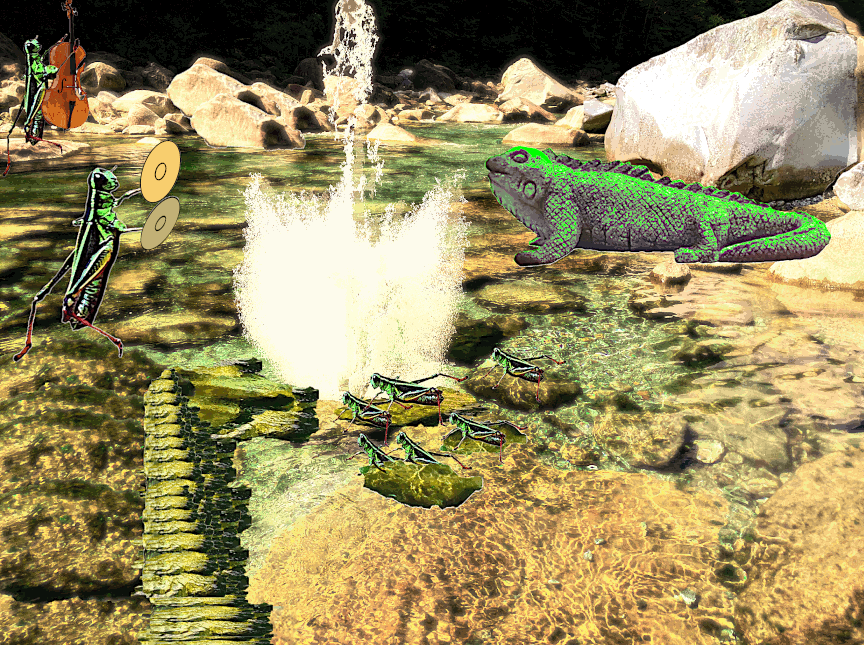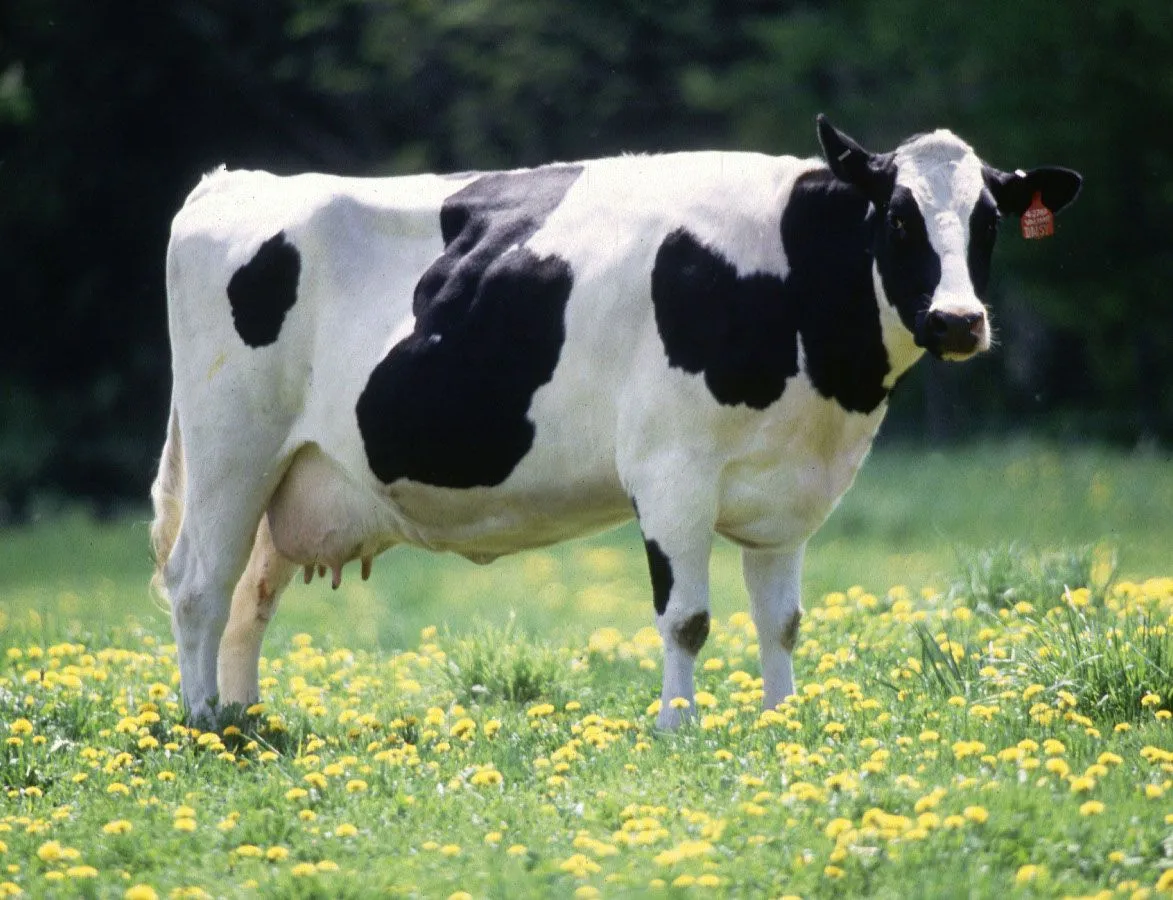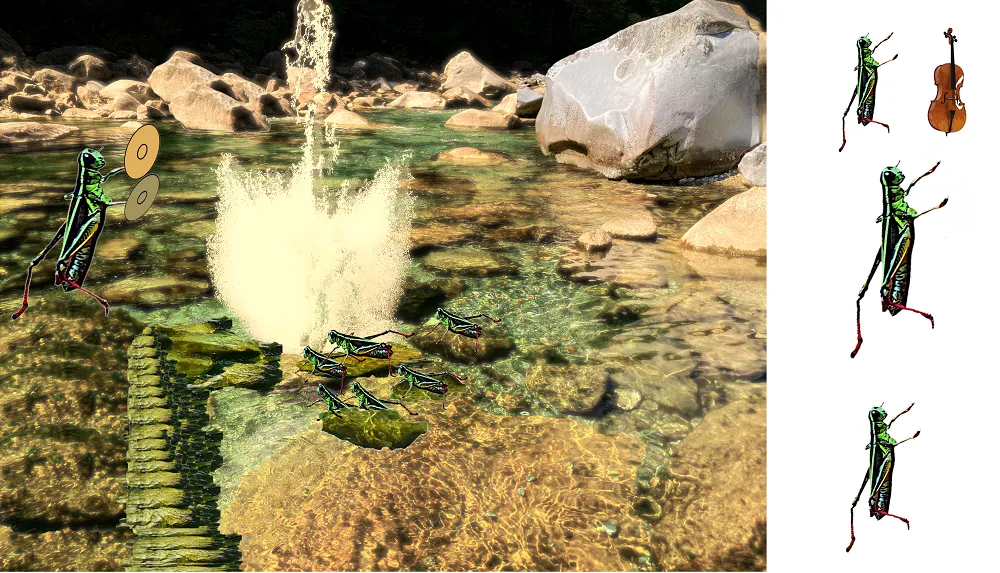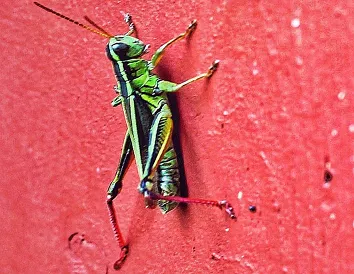Midnight Concert

Template Photo, by @shaka

When I saw @shaka's beautiful template photo this week I knew I would create a collage that had an elevated theme. I wanted to keep the charm of the picture, so I thought of music, and a water spout. The insects and the iguana were fun parts of my fantasy.
After finishing my collage, I wondered, Could a grasshopper or iguana actually respond to music? From that simple question, the rest of this blog followed. I hope you have half the fun reading, that I had in researching the question.
The iguana in my collage taps its foot to the clash of symbols and sonorous strumming of the double bass. Is this pure fantasy, or do animals indeed listen to and appreciate music? The evidence is in: Many animals actually do listen to music, though some prefer slow jazz and classical music to heavy metal. As a matter of fact, studies have shown that animals pay attention to cross-species music (such as bird songs), in addition to music spawned by humans.
African Grey Parrot, Sylvan Heights Waterfowl Park

Credit: bobistraveling. Used under CC 2.0 license. African Grey parrots not only respond to music but have very specific preferences. They have been known to self-select songs.
Darwin believed that the human response to music was evolutionary...based in biology. To test that theory, researchers look for evidence of the response in different species. The results of the research has been mixed, as reported in this edition of the MIT Reader.
In the MIT report, beat perception was discovered in at least one sea lion. Chimpanzees were found to have a 'rudimentary' form of beat perception, and cockatoos definitely were found to have it. The conclusion of this research is, "Darwin was partly right...musicality has a biological basis and a long evolutionary history."
So, how do individual species respond? In many of these species, it is not beat perception or tonality that can necessarily be inferred from the response. Different species respond to vibrations that travel through the air.. .noise levels. Some of the responses described below may reflect that.
Cats: A 2015 article published in Animal Behavior Science reports that cats only like music that is 'appropriate' to their species. This means, "music... must be in the frequency range and with similar tempos to those used in natural communication" by other cats. Human music, music that might appeal to you or me, leaves them cold.
Cows: According to U. S. Dairy News, if you play the right music, a cow will reward you with good milk output. This is a discovery accepted by milk producers so completely that some ran a music contest judged by, you know who--cows. Songs were submitted and played to cows. The song that prompted cows to produce the most milk won. Type of music favored by cows? "The Likes of Mozart and Beethoven".
Dairy Cow

Credit: Keith Weller, USDA. Public domain
Dogs: Two sources I consulted agree that music can relax dogs, but only one looks at the kind of music that has this effect. In an article posted on PetMD, the authors assert that "there is enough (research) to suggest that music can be used to increase relaxed behaviors in dogs". Classical music once again won out over pop or heavy metal. The music was even more relaxing for the dogs than conversation. Remarkably, dogs seemed to prefer their classical music delivered as a solo piano performance. A second study, in journal Animals, looked at using music to reduce anxiety in veterinary practice. While cautioning that more research needs to be done, the authors of this article conclude: "Given the cost effectiveness and ease of implementation, music therapy holds promise in veterinary medicine and animal welfare".
Sea lion: It seems that sea lions not only listen to music, but dance to it. In an article, "A Sea Lion in Boogie Wonderland—Do Animals Dance?", psychology professor Ira E. Hyman describes Ronan the sea lion who "was trained to listen to music, extract the beat, and bob her head in time". Ronan was not just performing by rote. If the music was slowed down or sped up, she changed her dance accordingly. Here is a YouTube video by Pinniped Lab that shows Ronan performing.

Chimpanzee: Chimpanzees show a definite response to music. Much as a human might, the chimps sway as music plays. It seems this is more evident in male chimps than female chimps. Chimps also hand clap and foot tap. Several studies I consulted suggest that the chimps prefer African and Indian music over other types.
Crocodiles: Researchers at Germany’s Ruhr-University Bochum (RUB), borrowed a Nile crocodile from a nearby zoo, gave it a mild sedative and restrained it in an MRI machine. Classical music, Bach specifically, was piped in and neural responses in the brain were measured. It turned out, the crocodile responded to the music. The response was similar to that seen in birds.
Nile Crocodiles (Crocodylus niloticus)

Image credit: NasserHalaweh. Used under CC 4.0 license
- Insects This is largely theoretical. The one study I found that cited a response from insects was done on mosquitoes in Malaysia, Thailand, Japan, and Indonesia. What this study found was that these particular mosquitoes (yellow fever mosquitoes) were repelled by the one song that was played, “Scary Monsters And Nice Sprites” by DJ Skrillex. There was a control group that was not serenaded. In the group exposed to the music, there was less mating and less feeding (extracting blood from hosts). The conclusion of the researchers? “There certainly is evidence that mosquitoes can hear and that you can manipulate behavior through sound”(quote from the head of the Department of Disease Control of London School of Hygiene and Tropical Medicine, Professor James Logan)
It took me just a few minutes to know what I wanted to do with @shaka's beautiful template photo. When decided to use insect musicians, I thought immediately of the LMAC Image Gallery. The Gallery is chock full of wonderful insect images.
Thank you @redheadpei for the grasshopper. Then I needed a spectacular creature to put in the audience along with the grasshoppers. A huge iguana fit the bill. Thank you, @muelli for that amazing picture!
I needed to borrow just two other items to complete my collage. These I found on Pixabay:
Cymbals Vector Free Image and a Double Bass Chrom72. Thank you!
The fountain at the center of the collage came from a photo I took for LIL, the Image Gallery (picture is not up there yet):

Here is an intermediate step in construction of the collage:

I used paint, paint 3D and Gimp to manipulate the images and create the layers for the GIF.
LMAC Contest and LIL, the Image Gallery
LMAC was started by @shaka a few years ago. It is one of the most vibrant art communities on Hive, although many who belong to the community are not artists. I certainly am not an artist.
Anyone on Hive may join the contest and anyone may contribute to/borrow from the Gallery. Rules and procedures for the contest may be found on @shaka's blog here. Rules and procedures for the gallery may be found here. Please keep in mind that all images in the gallery are public domain and may be used without copyright restriction.
I don't compete in the collage contest, but almost always make a collage. Not only is it fun, but as @wito7 said this week in his collage blog, "The contest that keeps our neurons moving and active week after week".
We are going on a short break but will return on September 15, 2022. Be sure to look for us then!
I hope everyone in the LMAC community and on Hive stays healthy, peaceful and productive during the break.

